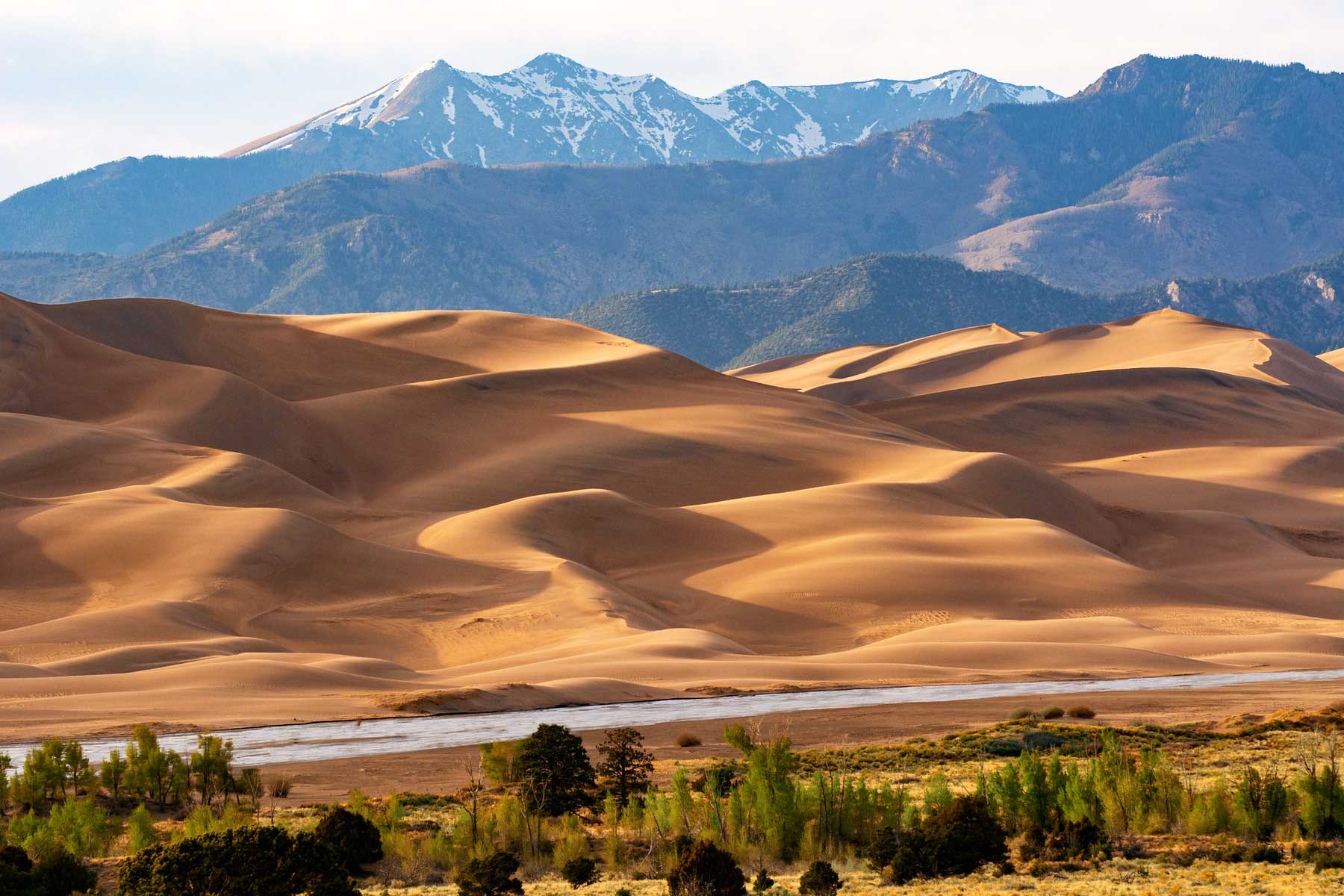
Sand dunes are not just ordinary piles of sand; they are breathtaking natural formations that can be found all over the world. These shifting hills of sand can be found in deserts, coastal areas, and even in some inland regions. The beauty and wonder of sand dunes have fascinated people for centuries, and their unique characteristics continue to astound researchers and visitors alike.
In this article, we will explore 18 astonishing facts about sand dunes that will leave you amazed. From their formation to their importance to the environment, we will uncover the hidden secrets behind these mesmerizing landscapes. So, sit back, relax, and prepare to be awed by the remarkable world of sand dunes.
Key Takeaways:
- Sand dunes are not just piles of sand – they come in different shapes and sizes, move and change shape, and even produce a booming sound when you walk on them!
- Sand dunes are more than just a cool place to visit – they play a crucial role in protecting coastlines, can reveal ancient treasures, and even influence local weather patterns.
Sand dunes come in various shapes and sizes.
From crescent-shaped barchan dunes to long linear ridges called seif dunes, sand dunes can take on a variety of forms. They can range in height from just a few meters to towering hundreds of meters above the ground.
Sand dunes are formed by wind or water.
The primary agents responsible for shaping sand dunes are wind and water. Wind-blown grains of sand accumulate to form dunes in arid regions, while in coastal areas, tides and currents play a role in dune formation.
Sand dunes can move and change shape.
Due to the constant action of wind, sand dunes are always shifting and changing shape. This process, known as dune migration, can lead to the gradual movement of dunes over time.
The largest sand dune in the world is in the Badain Jaran Desert, China.
This massive sand dune, known as the Bilutu Peak, reaches a height of approximately 500 meters, making it the tallest sand dune on Earth.
There are also underwater sand dunes.
In certain underwater environments such as rivers and the ocean floor, sand dunes can form underwater. These submerged dunes play an important role in shaping the underwater landscape.
Sand dunes can create unique ecosystems.
Despite the harsh conditions, sand dunes are home to a surprising variety of plants and animals. These organisms have adapted to survive in the extreme temperatures and limited water availability of the dune environment.
Sand dunes can produce a booming sound.
In certain conditions, when the sand is of a specific grain size and humidity, walking on a sand dune can produce a low-frequency sound known as the “booming” or “singing” sand phenomenon.
Sand dunes are popular tourist destinations.
Visiting sand dunes has become a popular activity for tourists around the world. Activities such as sandboarding and camel rides are often offered to enhance the dune experience.
The Sahara Desert is home to some of the world’s most iconic sand dunes.
The Sahara Desert in Africa is known for its vast expanse of sand and iconic dunes. The towering dunes of Erg Chebbi and Erg Chigaga are among the most visited dunes in the Sahara.
Sand dunes have been used as filming locations.
Due to their unique and picturesque qualities, sand dunes have been featured in numerous films and television shows. Some notable examples include the Sahara Desert scenes in the movie “Lawrence of Arabia” and the “Star Wars” series.
Sand dunes can reveal archaeological treasures.
Over time, sand dunes can bury ancient structures and artifacts. In certain cases, when the dunes shift or erode, archaeological treasures are revealed, providing valuable insights into the past.
Sand dunes play a crucial role in coastal protection.
Dunes act as a natural barrier against coastal erosion and storm surges. The accumulation of sand helps protect the land behind them from the destructive power of the ocean.
Some sand dunes exhibit unique colors.
Due to the presence of different minerals and sediments, certain sand dunes can have vibrant colors, ranging from red and orange to pink and even white.
Sand dunes can be found on other planets.
Sand dunes are not exclusive to Earth. They have also been detected on other planets and moons, such as Mars and Saturn’s moon, Titan.
The movement of sand dunes can be measured using satellite imagery.
Advancements in satellite technology have made it possible to monitor and measure the movement of sand dunes from space. This data helps scientists better understand the dynamics of dune systems.
Sand dunes can influence weather patterns.
Large sand dunes can have an impact on local weather patterns by altering wind flow and creating areas of increased turbulence.
Sand dunes can reveal the direction of prevailing winds.
The shape and alignment of sand dunes can provide valuable information about the prevailing wind direction in a particular region.
Sand dunes are constantly evolving.
Sand dunes are dynamic landforms that are constantly shaped by natural elements such as wind, water, and vegetation. They serve as a reminder of the ever-changing nature of our planet.
Conclusion
Sand dunes are truly fascinating natural formations that offer both beauty and intrigue. From their diverse shapes and sizes to their importance in various ecosystems, there is so much to appreciate about sand dunes. They not only provide a habitat for unique plant and animal species but also offer recreational opportunities for people around the world.Understanding the formation and characteristics of sand dunes can help us appreciate the dynamic nature of our planet and the processes that shape it. Whether it’s the towering dunes of the Sahara or the rolling dunes of coastal areas, sand dunes continue to captivate our imagination.So, the next time you encounter a sand dune, take a closer look and marvel at the wondrous natural processes that have created such awe-inspiring formations. And remember, sand dunes have a story to tell, one that spans centuries and connects us to the intricate workings of our Earth.
FAQs
1. How are sand dunes formed?
Sand dunes are formed when wind or water carries sand particles and deposits them in a specific location. Over time, as the sand accumulates, it is shaped by wind patterns and other environmental factors, creating unique dune formations.
2. Are sand dunes found only in deserts?
While deserts are well-known for their vast sand dunes, they can also be found in coastal areas, riverbeds, and even some mountainous regions. Sand dunes are formed wherever there is an ample supply of sand and the right environmental conditions for their formation.
3. Can sand dunes move?
Yes, sand dunes are constantly on the move. They can migrate over time due to the wind’s prevailing direction, and even smaller dunes within a larger dune field can shift and change shape. This movement is known as sand dune migration.
4. Do sand dunes have any ecological importance?
Yes, sand dunes play a crucial role in supporting unique ecosystems. They provide a habitat for specialized plant and animal species that have adapted to survive in harsh, sandy environments. Sand dunes also help protect coastal areas from erosion and provide natural barriers against storm surges.
5. Are sand dunes stable structures?
While sand dunes may appear stable, they are actually quite dynamic. The shape and size of a sand dune can change over time as a result of wind patterns and other factors. Dune stabilization efforts, such as planting vegetation, can help slow down the movement and erosion of sand dunes.
6. Can you climb sand dunes?
Yes, climbing sand dunes can be a fun and exhilarating experience. However, it’s important to tread lightly and respect the fragile nature of the dune ecosystem. Stick to designated paths or areas where climbing is permitted to minimize the impact on the dunes and their inhabitants.
7. Are there any famous sand dunes?
Yes, there are several famous sand dunes around the world. Some notable examples include the towering dunes of the Sahara Desert in Africa, the stunning dunes of Namib Desert in Namibia, and the picturesque Great Sand Dunes National Park in the United States.
8. Can sand dunes be used for recreational activities?
Absolutely! Sand dunes offer a wide range of recreational opportunities such as sandboarding, sand sledding, dune buggy rides, and even camel rides in some desert regions. These activities allow visitors to enjoy the beauty and adventure of sand dunes in a responsible and sustainable manner.
Hungry for more captivating facts about sand dunes? Quench your thirst for knowledge with our articles on astounding sand dune facts, mind-blowing insights into barchan dunes, and fascinating revelations about aeolian processes. From the mesmerizing shapes and colors of sand dunes to their crucial role in shaping our planet's landscapes, these articles will take you on a thrilling journey through the world of sand. Prepare to be amazed as we explore the secrets hidden within these seemingly simple mounds of sand. Click now and let your curiosity guide you through this awe-inspiring realm!
Was this page helpful?
Our commitment to delivering trustworthy and engaging content is at the heart of what we do. Each fact on our site is contributed by real users like you, bringing a wealth of diverse insights and information. To ensure the highest standards of accuracy and reliability, our dedicated editors meticulously review each submission. This process guarantees that the facts we share are not only fascinating but also credible. Trust in our commitment to quality and authenticity as you explore and learn with us.


